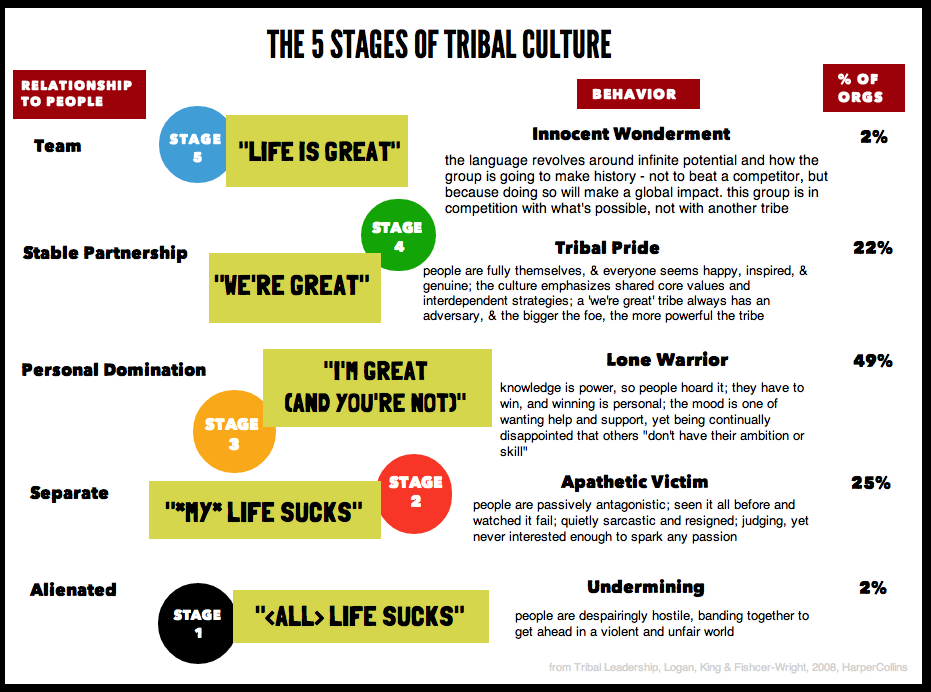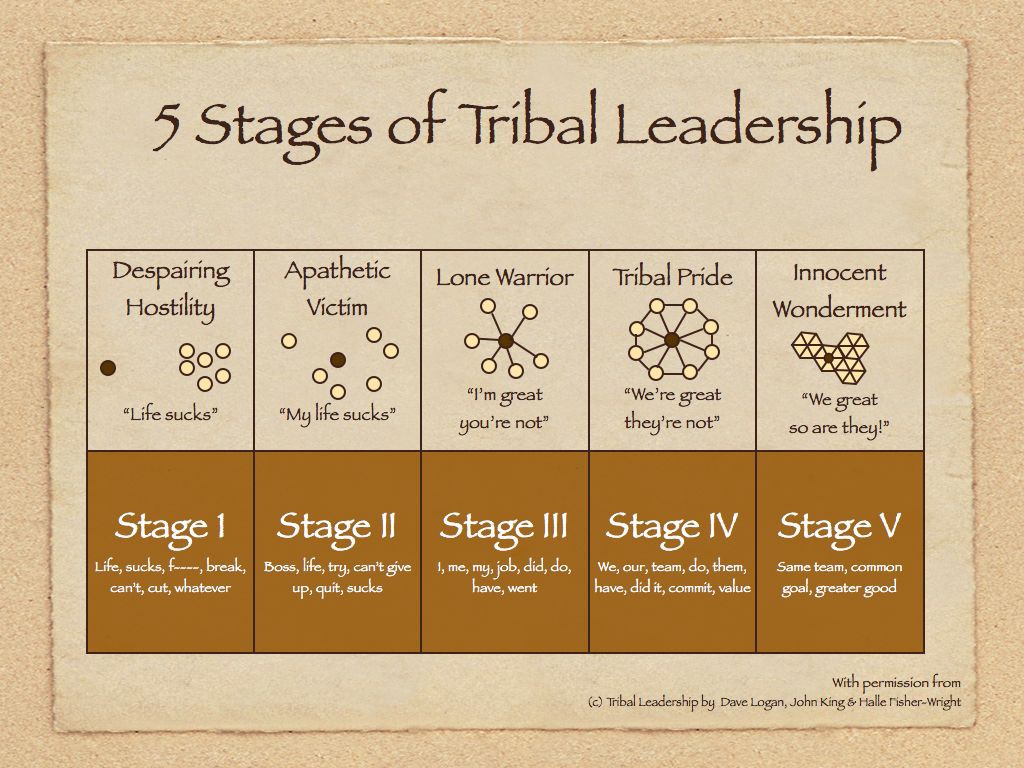Summary - Tribal Leadership
by Dave Logan, John King, Halee Fischer-Wright
What Is a Tribe?
- A tribe is a group of people.
- A small company is a tribe. A large company is a tribe of tribes.
- What makes some tribes more effective than others is culture. Stage 5 tribes out perform stage 4 tribes.
What Is Tribal Leadership?
- Tribal Leadership focuses on language and behavior within a culture
- It does not seek to address cognitions, beliefs, attitudes, or other factors we cannot directly observe.
- Each cultural stage has its own way of speaking, types of behavior, and structures of relationships.
- Tribal Leaders do two things:
- listen for which cultures exist in their tribes and
- upgrade those tribes using specific leverage points.

To Listen for Which Cultures Exist in Their Tribes, Tribal Leaders Must Know the Following
Summary of Stage One
- The person at Stage One is alienated from others, expressing the view that "life sucks."
- When people at this stage cluster together, their behavior expresses despairing hostility, such as in a gang.
Summary of Stage Two
- The person at Stage Two is separate from others, although unlike Stage One, Stage Two people are surrounded by people who seem to have some power that they lack. As a result, their language expresses "my life sucks." Unlike Stage One, a person at Stage Two communicates the view that others' lives seem to be working.
- When people at this stage cluster together, their behavior is characteristic of being apathetic victims.
Summary of Stage Three
- The person at Stage Three is connected to others in a series of dyadic (two-person) relationships. The language of this stage expresses "I'm great," and in the background unstated-is "and you're not."
- When people at Stage Three cluster together, they attempt to outperform one another (on an individual basis) and put one another down. Although this is often done under the veil of humor, the effect is the same: each is striving for dominance. Individuals' behavior expresses a "lone warrior" ethos, and collectively, the culture becomes the "wild, wild west."
Summary of Stage Four
- The person forms structures called triads, in which they build values-based relationships between others. At the same time, the words of Stage Four people are centered on "we're great and, in the background, "and they're not." The "they" is another tribe-in the same company or in another.
- When people at Stage Four cluster together, they radiate tribal pride.
Summary of Stage Five
- A person at Stage Five expresses "life is great." Five shares the same characteristics of Four, except that there is no "they." As a result, these people form ever-growing networks with anyone whose values resonate with their own. The only Stage Five cultures we have observed in corporate settings) exist as long as a history-making project lasts or as long as the tribe is so far ahead of its competitors that they are irrelevant.
- Once the situation changes, the culture regresses to Stage Four, where it can move forward once a new opportunity arises or is engineered. The behavior of Stage Five expresses innocent wonderment.

FIGURE 1: SUMMARY OF TRIBAL LEADERSHIP LANGUAGE AND STRUCTURES. NOTE THAT THE PERSON IN QUESTION IS THE CIRCLE ON THE RIGHT COLUMN-GOING FROM ALIENATED AT STAGE ONE TO PART OF AN EVER-GROWING NETWORK AT STAGE FIVE
Leverage Points and Success Indicators to Upgrade Tribal Culture
For a Person at Stage One
If the person is willing to move forward, encourage him to go where the action is. This means having lunch with coworkers, attending social functions, and going to meetings.
- Furthermore, encourage him to notice ways in which life itself works. For example, a person can notice that your life is pretty good, so it's possible that his may improve.
- Encourage him to cut ties with people who share the "life sucks" language.
SUCCESS INDICATORS
- He will use "my life sucks" language, as opposed to "life sucks." In other words, his concern has shifted from a generalized gripe to a specific set of reasons why his life doesn't function as it should. In particular, he will compare himself to others' abilities, social advantages, and, most of all, interpersonal connections.
- He will exhibit the passive apathy of Stage Two, as opposed to the despairing hostility of Stage One. This shift may appear as a setback to people who aren't familiar with Tribal Leadership: in fact, it is a major step for ward.
- He will cut his social ties to people who are in Stage One.
For a Person at Stage Two
- Encourage her to make a friend. Then another friend. Then another friend. In other words, encourage her to establish dyadic (two-person) relationships.
- Encourage her to establish relationships with people who are at late Stage Three. Such individuals can be identified by their eagerness to mentor others into becoming mini-versions of themselves. (However, the same individuals will not tolerate another's becoming greater than they are.)
- In one-on-one sessions, show her how her work does make an impact. In particular, show her areas where she is competent and where her strengths are. In the same meeting, point out abilities she has that she has not yet developed, but be careful to make the tone of these discussions positive.
- Assign her projects that she can do well in a short time.
- These assignments should not require excessive follow-up or nagging, as this behavior may reinforce her "my life sucks" language.
SUCCESS INDICATORS
- She will use "I'm great" language, as opposed to "my life sucks." She may name-drop, point to her own accomplishments, and brag. Many of her sentences will start with "I."
- She will exhibit the lone warrior spirit of Stage Three, often comparing herself with her coworkers and using
- disparaging language like "What's wrong with them?" and "If they tried, they'd succeed."
For a Person at Stage Three
- Encourage him to form triads (three-person relation ships). In particular, he should introduce his contacts to one another by pointing to (1) shared or resonant core values, (2) overlapping self-interest, and (3) a specific opportunity where each can contribute to the work of the other. For ex ample: "I've been wanting to introduce you for a long time. You both share a love of the arts and are focused on integrity, and you're aboveboard people. You're both working on marketing plans, and I thought you may want to compare notes because you're using different approaches. Also, Jack here is an expert on market segmentation, and Kathy is a master of promotion plans, so I thought you each might be able to save the other time."
- Encourage him to work on projects that are bigger than anything he can do alone. In short, assign him work that requires partnership.
- Point out that his success has come through his own efforts, but that the next level of success is going to re quire a totally different style. In other words, show him that what's brought him to this point will not be enough to move him forward.
- Describe role models (ideally in the company) that are exhibiting Stage Four behavior. You'll know these individuals by (1) their focus on "we," (2) the number of triads in their networks, and (3) the success that comes from groups.
- When the person complains that he doesn't have time and that others aren't as good (the two chief gripes at Stage Three), show that he has crafted his work life so that no one can really contribute to him.
- Tell stories about the time you made the transition from Stage Three to Stage Four.
- Coach him that real power comes not from knowledge • but from networks, and that there is more leverage in wis dom than in information. Compliment his successes-and they are likely numerous-and convey that you're on his side. Also help him to notice that his goals require getting more done than he is able to do alone, no matter how smart and talented he is.
- Encourage him to manage using transparency, as much as is possible under corporate policy. Coach him to not follow the Stage Three tendency to tell them only what they need to know. Rather, encourage him to over communicate.
SUCCESS INDICATORS
- He will substitute "L" language for "we." When people ask about the secret of his success, he will point to his team, not to himself.
- He will actively form triads, and his network will expand from a few dozen to several hundred.
- He will work less, and yet get more done.
- His complaints about there's not enough time" and "no one is as good" will cease.
- The results for which he is accountable will increase by at least 30 percent.
- He will communicate with transparency.
- He will communicate more information, and more often.
For a Person at Stage Four
- Stabilize her at Stage Four by ensuring that her triads are based on values, advantages, and opportunity.
- Encourage her to use the strategy process in Chapter 11 with her team. In particular, encourage her to run sessions that explore the team's core values, its sense of a noble cause, outcomes that would inspire the team, its as sets, and then its behaviors (who would do what). In short, encourage her to pick projects that are more of a stretch and that accomplish bigger and bigger results, by working more in partnership with other people.
- Once she is fully stable at Stage Four (which you can measure by her use of "we're great" language and her networked triads of relationships), encourage her team to take advantage of market conditions to make history.
- If the market doesn't offer the right conditions, engineer an opportunity,
- Recruit others to the tribe who share the values of the group's strategy.
- When the team hits difficulties, point people to others for solutions. Encourage her to not solve problems. as doing so is consistent with "I'm great and you're not."
- Perform regular "oil changes" with the team. In this process, she should lead a discussion about (1) what is working well. (2) what is not working well, and (3) what the team can do make the things that are not working well, work.
SUCCESS INDICATORS
- She will use "life is great" language rather than "we're great and they're not)."
- She will seek out ever more challenging projects, and her network will include an almost stunning amount of diversity-but mostly people who, like her, have owned and then left Stage Three.
- She will make decisions about how to spend her time based on the tribe's core values and noble cause.
- She will appear to be an embodiment of the tribe's strategy, especially its values.
Goal of Tribal Leadership
• Tribal Leaders upgrade as many people-and clusters of people-as are willing and able to move forward to Stage Four, the zone of tribal pride.
